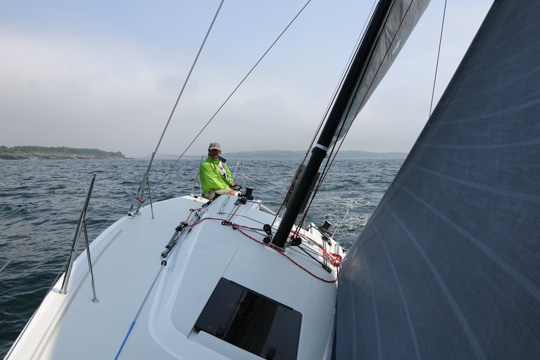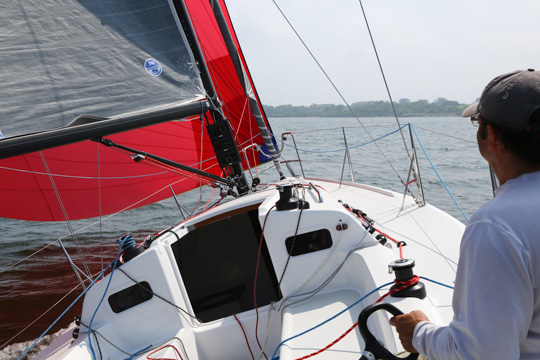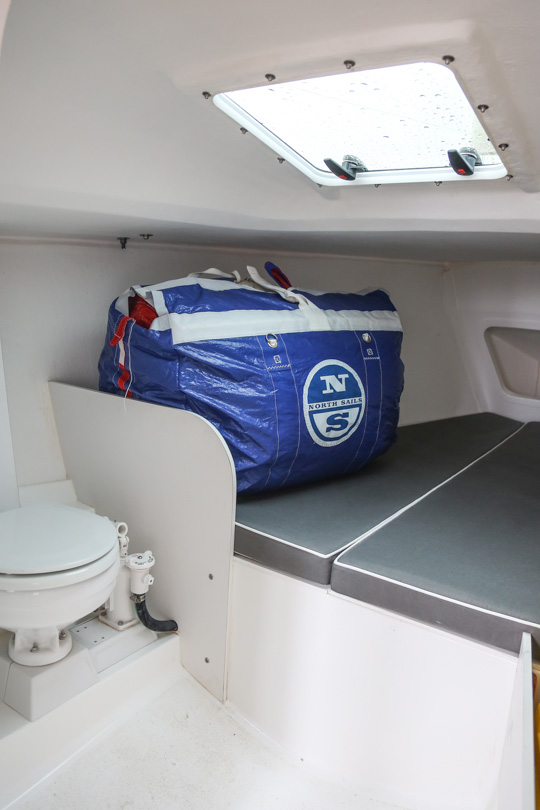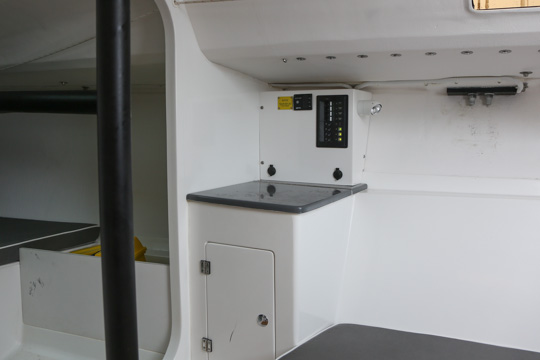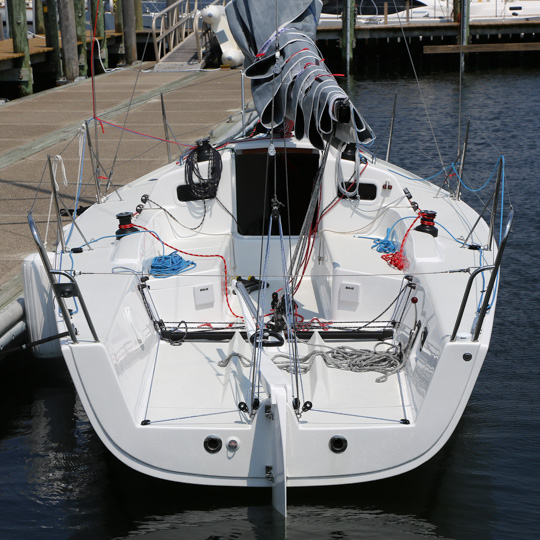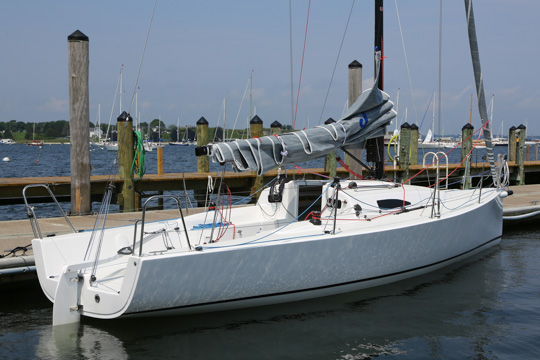
The weather wasn’t cooperating when we left the slip at NYYC in Newport. Rain and fog, but at least some breeze. The J/88 looked really good, even from afar, and there were positive comments from the guys working at the dock.
It looked sleek, clean and fast even when it’s parked. Just like the J/111 that we race ourselves. I hate to admit it, but the J/88 actually look even better from some angles…

The first thing you notice is the co*ckpit. It’s huge. It feels like on the J/111, but without the wheel. Great access to mainsheet and fine tune, traveller and backstay.Only possible improvement would be to add more purchase to the backstay, since you really need it to de-power the main.
The layout works both with a dedicated mainsail trimmer or if the helmsman is doing everything. Shorthanded you have great access to the jib winches as well. I loved to be able to sit well forward to get the weight right in the light stuff.

I especially liked the big foot rests that stretches all the way aft.
On the US boats it’s a 12 hp Yanmar, but I’ll expect a Volvo-Penta on the boats being built in Europe. Enough power to drive the boat at 7.5 knots at full RPM and almost 7 at cruising speed.

Nothing very special here. Furler on port side of coach roof and tack-line on starboard. Inhauler for the jib is adjusted to windward. On the J/111 the original layout had adjustment to leeward, which I didn’t like. One possible improvement, that we implemented on the J/111, would be to replace the cam cleat with a swivel cleat further forward to be able to adjust the inhauler both from the rail or from the trimmers position to leeward.

Clean and tidy.

The deck layout is very similar to the J/111.

Deck stepped mast.

New flush hatch in a small recess. Nice.
Below deck furler from Harken
We first went upwind in 6-7 knots of breeze, short tacking out to Castle Hill. The boat tracked well and felt very similar to the J/111. You need to get the bow down to power up and go for speed. The helmsman’s position is very good with good foot-rests and the ability to sit upright under heel. Everything is close by, and visibility is good.
Being narrow, just like the J/70 and J/111, it’s ok to heel without affecting the speed to much. Also the rudder doesn’t load up like on many wider cruiser/racers.This makes it a great boat to race doublehanded or with family and friends without to much focus on hiking. Naturally flat is fast, so you need to be active on the main sheet.
After we passed Hull Cove and tacked towards the blue sky, wind increased and we reached hull speed at 6.5 knots. We had a short discussion on rating and performance compared to other boats. Upwind the J/88 should match the J/105 but be significantly faster downwind.
Close hauled with a sheeting angle of 6.5 degrees, which is a base setting. Again, easy to adjust under load.
After turning back, we popped the chute. Easy handling as on all J/boats but significantly easier/lighter to manage than the J/111 that can be quite heavy with big chutes.
Intant acceleration and away we went.The thresholdfor planing downwind should be ~14 knots, depending on crew weight. This is right between the J/70 and the J/111 which makes sense. We had to head up to get on a plane as the wind stayed below 10 knots.
I also tried to provoke the boat by heading up and going to high. The rudder had a firm grip and I felt I could push the boat even harder than the J/111. Having a deep free-hanging rudder naturally helps.
Stuart Johnstone was my host for the day.It’s great to get together with the team from J/boats. All are avid sailors that actively race their boats. Stu was off to do the Chicago-Macinac on J/111 Fleetwing, so we got into a deeper discussion on code zeros…
On the comparison with it’s sisters, I asked designer Alan Johnstone to comment on the differences between the boats:
The J/88, like every new J/Boat we develop, is designed to be versatile, forgiving, easy to handle with great performance with an ultimate goal to encourage participation by a wide range of sailors and family members. The trade-offs that are made to achieve these goals differ from model to model depending on size range, purpose and priorities.
The J/111 was designed to offer the best performance value to the sailing market by offering thoroughly modern and exciting performance. This is achieved with very efficient and high aspect carbon rig plan with oversized mainsail girths and a big masthead asymmetrical flown from a long bow sprit. The rig is then combined with a high tech low VCG keel and very deliberate selection of items for the interior to keep the total weight of the boat light yet retain the durability that J/Boat owners expect. Standing headroom with an open and functional interior layout allows the versatility for cruising and weekend comfort between races. This boat was conceived to offer pure J/Boat performance with a hull shape that is uncompromised to racing handicap rules. This was not to be overpowering performance like some large extreme sportboats, but rather an easy to handle and exciting modern keelboat platform with an ability to plane downwind. Acceptance for the boat quickly grew and in a very short period of time the J/111 class achieved international one-design status. Today one-design fleets are growing around the world and next week there will be 11 J/111s racing in the 2013 Chicago Mac race.
For the J/70 it was very important to have a lifting keel for easy trailerability and this creates some challenges for the rig configuration and placement in the boat. (Lifting a keel into the co*ckpit and still allowing for a small interior cabin between the front of the keel and the mast, for instance). That trade-off is not necessary for the larger J/88 and J/111, both with fixed keels, allowing more freedom to place the rig and keel in the boat. The J/70 is also designed to fit inside a standard 40′ shipping container so she is narrow enough on deck to allow this. This trade-off limits the RM generated by crew hiking on the weather rail, and on small boats crew is a large percentage of the total weight and stability of the boat. Every inch of beam counts. The compact rig height of the J/70, when compared proportionally to the J/88 and J/111, is matched with this limit to available beam. Too much rig and the boat will become impossible to handle in big breeze, too little rig and it suffers in light air. The square-top style mainsail and large mainsail girths and a bit more mast rake than normal are added for extra horsepower, to limit mast height, and to help balance the rig plan.
The square top mainsail with “gaff batten” and longer backstay crane of the J/88 is a development of the J/70 rig. This configuration allows a simple mast and spreader configuration and retains the functionality and safety of a proper backstay. It requires a stiffer slightly heavier carbon mast at the top but allows superior bend control of the mainsail for depowering across a large wind range and again reduces the total rig height. The J/88 also shares the deck stepped mast configuration of the J/70 and a single point lift bar to allow launching and hauling from a yacht club hoist and an A-frame or gin pole to raise and lower the mast. This as an alternative to reliance on expensive boat yards and travel lifts. The deck stepped mast also simplifies commissioning & keeps water out of the interior.
The large co*ckpit and the functional cabin combination in the J/88 is only made possible by incorporating a transom mounted rudder. The J/88 rudder is deliberately large and has positive balance allowing a light feel across all sailing and heel angles and good control with the big masthead asymmetric kite. Like the J/70, the J/88 also has a below-deck Harken jib furler that allows the jib to sweep the deck. Standard in-haulers to allow very tight jib sheeting angles.
To summarize, the J/111, J/70 and J/88 have specific rig configurations, proportions and features that match the goals and trade-offs for each boat. I am particularly pleased with the initial sea trials of the new J/88 and I am confident she will become an exciting offshore performance boat that family and friends will enjoy for many years to come.
Even if the interior isn’t the main reason for buying a J/88, it’s well laid out and should work great for a weekend cruise. The layout is similar to the J/92 and J/105 withtwo full length settees, galley sink, private head forward and optional V-berth.
After the sail we got back to the NYYC. After a grim morning the day turned out to be perfect for sailing. More people were waiting to test the boat, and I had already made up my mind about the boat.
- LOA 8.90
- LWL 8.18
- Beam 2.90
- Standard Draft 1.98
- Displacement 2,2
- Diesel Aux. Engine 12 hp
- 100% SA 40.80
- SA/Dspl 24
- Dspl/L 112
After sailing both the J/70 and the J/111 I wasn’t expecting any big surprises. It’s fast, fun and easy to manage. At $125k ex VAT plus sails and electronics it might sound expensive, especially compared to a used J/92S or J/105. But looking at the specs it’s another boat, that will hold it’s value (and create lots of smiles) over the next few years.
Alan Johnstone have found a formula that’s working very well, and the numbers speaks for themselves: over 350 J/70 and almost 100 J/111 sold. And there are already 30 boats sold of the new J/88.
We’ll see the boat in Europe at the Southampton Boat Show, and I’m sure that J/boats will start production in France during the winter.


